#learn python
Text
Random Python Resources | Resources ✨
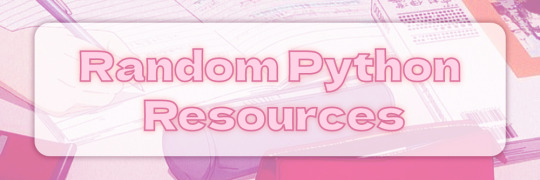
Hiya! I found some Python links in one of my bookmark folders so I thought I would just share them - might be helpful to someone!
Think Python 2 (book) - LINK
Learning Python (book) - LINK
Learn Python from beginner to advanced (site) - LINK
Python Tutorial (book) - LINK
Introduction to Programming with Python (16-hour video) - LINK
Python Learning Roadmap (site) - LINK
Good luck with your studies 👩🏾🎓👍🏾💗

#resources#python#coding#codeblr#programming#progblr#studying#studyblr#how to learn python#learn python#tech
302 notes
·
View notes
Text
Is it possible to learn Python by using Android apps?
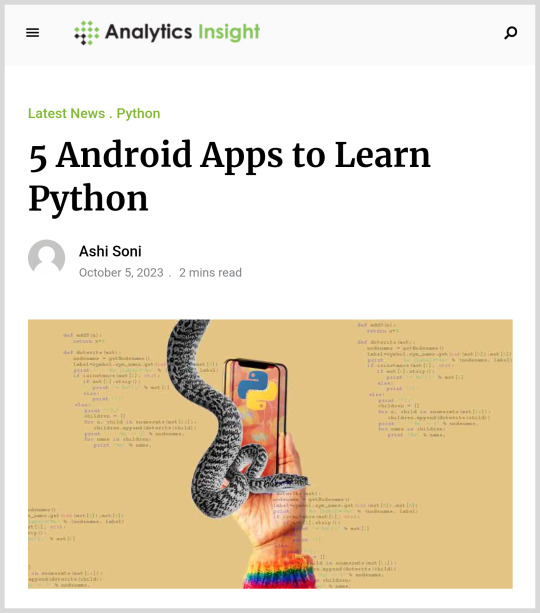
Post #92: Analytics Insight, 5 Android Apps To Learn Python, 2023.
#programming#coding#education#i love coding#learning#coding is fun#i love python#coding for kids#programming language#i love programming#analytics insight#android apps#python coding#learn python#python tutorial#python#python programming
35 notes
·
View notes
Text
python - a brief history
In 1989, Guido van Rossum, a Dutch computer scientist, started working on a new programming language that would be easy to learn and use. He named it after Monty Python's Flying Circus, his favorite TV show.
The language quickly gained popularity and a cult following among developers who loved its simplicity and ease of use. Python soon became the language of choice for scientific and academic communities.
As Python's popularity grew, it faced some significant hurdles. In the early days, critics panned the language for being slow and inefficient compared to other programming languages. However, the Python community was undeterred and developed several optimization techniques and libraries to improve performance.
In 2000, Guido van Rossum released Python 2.0, which introduced a number of major new features and improvements, including list comprehensions, a garbage collector, and support for Unicode. This version of the language solidified its position as a powerful and versatile programming language.
Over time, Python faced some new challenges. The release of Python 3.0 in 2008 introduced significant changes that caused compatibility issues with earlier versions of the language. However, the Python community rallied to provide tools and resources to help developers transition to the new version.
Despite these challenges, Python has continued to grow and evolve. Today, it is one of the most popular programming languages in the world, with a vast ecosystem of libraries and tools. Python is used for everything from web development and data analysis to scientific computing and artificial intelligence.
Python's success can be attributed to the passion and dedication of its community, who have worked tirelessly to overcome challenges and make the language accessible to everyone. Guido van Rossum may have created Python, but it is the community that has made it a force to be reckoned with in the world of programming.
#python#history#learn#programming language#programming#computer language#history of#learn python#python programming#computer history#digital technology#developers#developer#info#information#birth of python#python the programming language#guido#rossum#python language#geek#nerd#nerdy#interpreted#interpreted language#fun#computer science#technology
93 notes
·
View notes
Text
How to Deploy a Python Django App to DigitalOcean?

Django is a high-level Python web framework that follows the Model-View-Controller (MVC) architectural pattern. It allows developers to build web applications quickly and easily by providing a structured and reusable codebase.
Read more at: https://elvanco.com/blog/how-to-deploy-a-python-django-app-to-digitalocean
21 notes
·
View notes
Text
Python Day 2
Today I am starting off with exercise 13. Exercise 13 introduces the concepts of variables, modules, and argv.
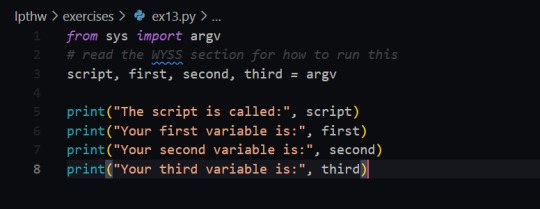
[ID: Exercise 13 code. It imports the argv module from sys, then uses argv to create 4 variables, script, first, second, and third. Next print() is used to print out the different variables /ID]





When calling the program I was confused as to why I got the error of too many variables. Looking into this I found that the first variable of 'argv' is always going to be the script. I then fixed that and added in script as the first variable.
Next for the study drill I wrote a new variable and updated the code to print the retrieved information.


Alrighty then - onto exercise 14. Exercise 14 is about practicing prompts and variables.
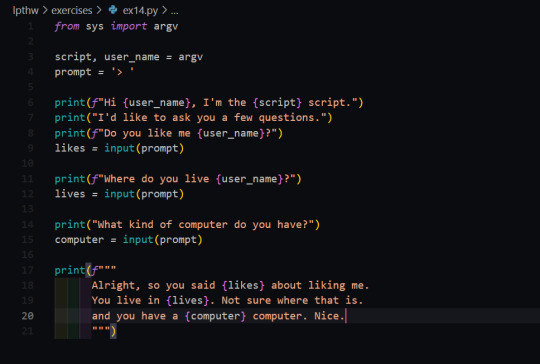

In the study drills I updated the script with a new prompt and print statement.
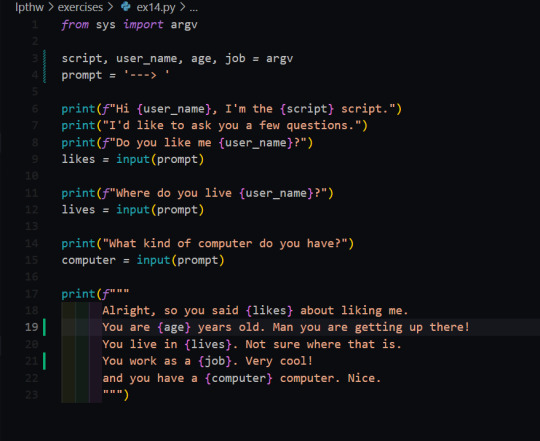
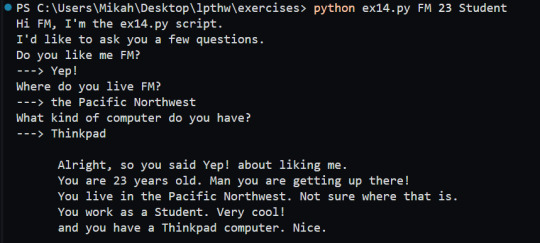
Exercise 15 is a simple program that prints out the contents of a file. An important thing to note is to always close the file when doing things like this!
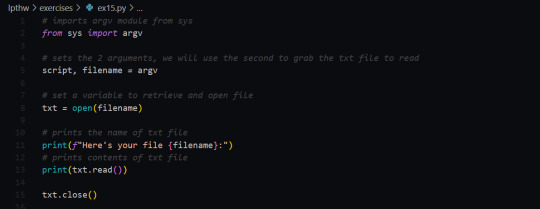
Exercise 16 practices making a copy of a file and then updating it with 3 lines from user input.
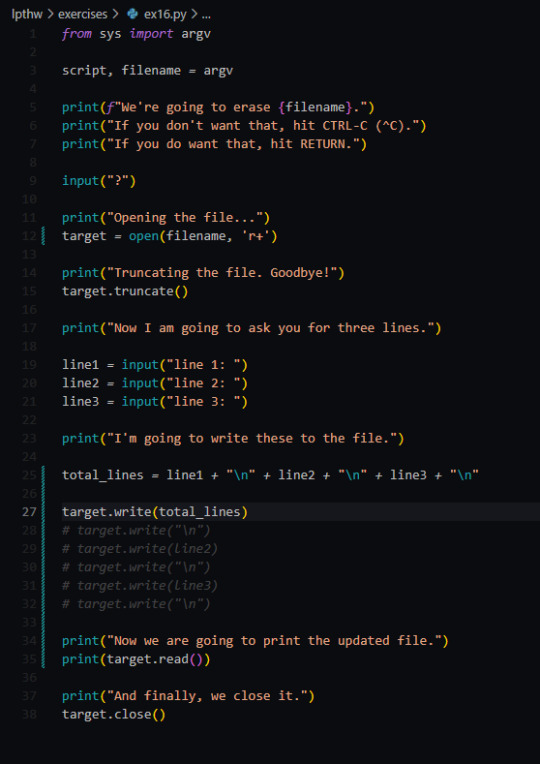
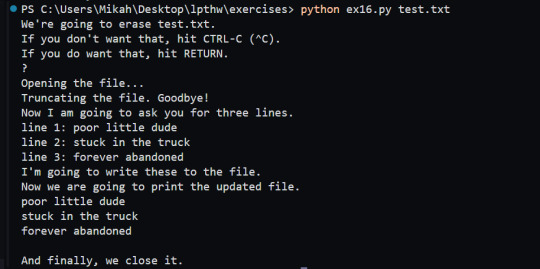
I ended up running into the issue where it was saying that it couldn't read the file. I ended up finding out that .read() starts from the cursor position - and if the cursor is at the end of the file from writing it you will not have your file printed.


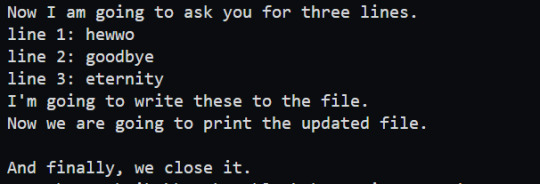

Exercise 17 is practicing copying files over and was relatively simple.
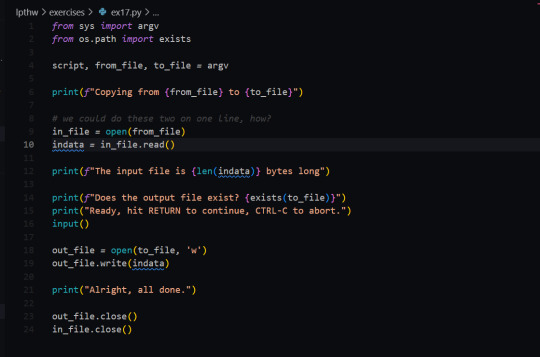

#learn python with F.M.#learn to code#learn python#coding resources#python#coding#lpthw#transgender programmer#codeblr#code#image undescribed#Sorry for not adding ID folks - my spoons are too low
4 notes
·
View notes
Text

es gracioso como hasta la conducta que mas nos puede molestar en otrxs... nos sale, de vez en cuando, como si nada... sin esfuerzo ni pensar. Eso tengo que aprender si si si, a escuchar si e m pr e e e ee e e e ✨
#importante#buenos aires#gofloresgo#the strokes#babosa#caracol#snail#helado#ice#flores#go flores go#aprender#learn#escuchar#amores#original art#learn french#learn colors#learn python#learn spanish#experience#importance#improve#lesson#successful#draw#drawing
153 notes
·
View notes
Text
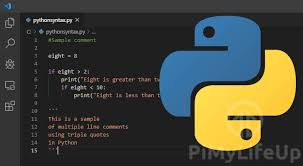
Python: What is it all about?
Python is a high-level, interpreted programming language.
A programming language is a formal language that is used to create instructions that can be executed by a computer. Programming languages are used to develop a wide range of software applications, from simple scripts to complex operating systems.
It is widely used for a variety of applications.
What is Python?
Python is a dynamic, object-oriented programming language.
A dynamic programming language is a programming language in which the type of a variable is not known until script is run. This is in contrast to static typing, in which the type of a variable is set explicitly .
It is an interpreted language, meaning that it is executed line by line by an interpreter, rather than being compiled into machine code like some other languages. This makes it easy to develop and test Python programs quickly and efficiently.
Python is also a general-purpose language, meaning that it can be used for a wide range of tasks. It comes with a comprehensive standard library that provides modules for common tasks such as file handling, networking, and data manipulation. This makes it easy to get started with Python and to develop complex applications without having to write a lot of code from scratch.
Origin of Python
Python was created by Guido van Rossum in the late 1980s as a successor to the ABC programming language. ABC was a simple, interpreted language that was designed for teaching programming concepts. However, van Rossum felt that ABC was too limited, and he wanted to create a more powerful and versatile language.
Python was influenced by a number of other programming languages, including C, Modula-3, and Lisp. Van Rossum wanted to create a language that was simple and easy to learn, but also powerful enough to be used for a variety of applications. He also wanted to create a language that was portable across different platforms.
Python was first released in 1991, and it quickly gained popularity as a teaching language and for scripting tasks. In the late 1990s and early 2000s, Python began to be used for more complex applications, such as web development and data science. Today, Python is one of the most popular programming languages in the world, and it is used for a wide variety of applications.
The name "Python" is a reference to the British comedy group Monty Python. Van Rossum was a fan of the group, and he thought that the name "Python" was appropriate for his new language because it was "short, unique, and slightly mysterious."
How is Python Used?
Python is used in a wide variety of applications, including:
Web development: Python is a popular choice for web development, thanks to its simplicity and the availability of powerful frameworks such as Django, Flask, FastAPI.
Data science: Python is widely used for data science and machine learning, thanks to its extensive data analysis and visualization libraries such as NumPy, Pandas, dask, Matplotlib, plotly, seaborn, alatair.
Machine learning: Python is a popular choice for machine learning, thanks to its support for a wide range of machine learning algorithms and libraries such as scikit-learn, TensorFlow, Keras, transformers, PyTorch.
Scripting: Python is often used for automating repetitive tasks or creating custom tools.
Advantages
Python offers a number of advantages over other programming languages, including:
Simplicity: Python is a relatively simple language to learn and use, making it a good choice for beginners.
Readability: Python code is known for its readability, making it easy to understand and maintain.
Extensibility: Python is highly extensible, thanks to its large community of developers and the availability of numerous libraries and frameworks.
Portability: Python is a cross-platform language, meaning that it can be run on a variety of operating systems without modification.
Drawbacks
Despite all of it's advantages, python also has several drawbacks.
Speed: Python is an interpreted language, which means that it is slower than compiled languages such as C++ and Java. This can be a disadvantage for applications that require high performance.
Memory usage: Python programs can use a lot of memory, especially when working with large datasets. This can be a disadvantage for applications that need to run on devices with limited memory.
Lack of type checking: Python is a dynamically typed language, which means that it does not check the types of variables at compile time. This can lead to errors that are difficult to find and debug.
Global interpreter lock (GIL): The GIL is a lock that prevents multiple threads from executing Python code simultaneously. This can be a disadvantage for applications that need to use multiple cores or processors.
5 notes
·
View notes
Text
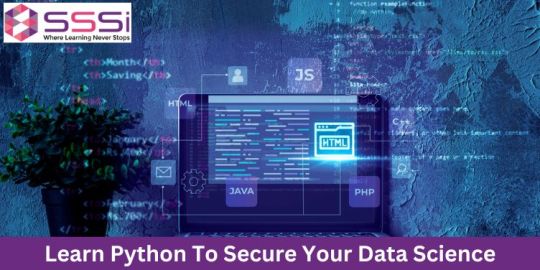
Learn Python To Secure Your Future In Data Science
Python is one of the most important coding or programming languages that is used by more than 8 million programmers as their main programming language.Now let's talk about how to learn Python. Python language is the basic and the easiest language compared to any other language.
To more info Visit us :- https://www.sssi.in/blog/engineering/learn-python-to-secure-your-future
#learn python#online training python#python developers#python basics#learn python for data analysis#python programming#coding python for beginners
2 notes
·
View notes
Text
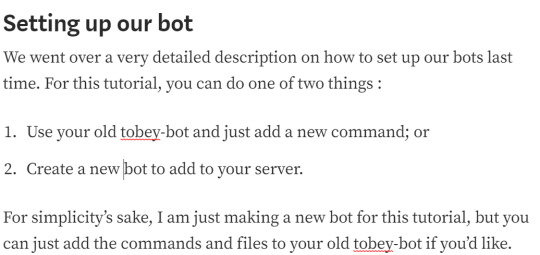
I have officially scheduled the jinx-bot tutorial for tomorrow morning! any guesses on what the command will be?
I am so proud to release this tutorial as from conception to frankenstein moment, it is my mind's baby lol. the bot I am basing jinx-bot off of was my first independent discord.py bot and will be have more of its commands featured in tutorials in the future.
more to come soon!
#discord.py#pips tutorials#discord bot#python#python programming#python tutorial#codeblr#studyblr#progblr#programming#programming tutorial#tech#comp sci#medium writers#medium tutorial#learn to code#learn python
16 notes
·
View notes
Text
16 notes
·
View notes
Text
Como hacer un "Hola Mundo" en python
1 Utiliza la palabra reservada print
2 Abre parentesis y comillas dobles ("")
3 Escribe dentro del parentesis ("Hola Mundo")
4 Ejecuta en la terminal
5 Listo!
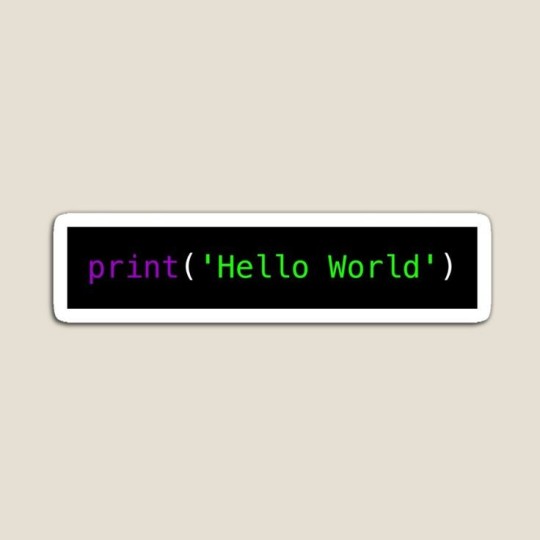
6 notes
·
View notes
Link
14 notes
·
View notes
Text
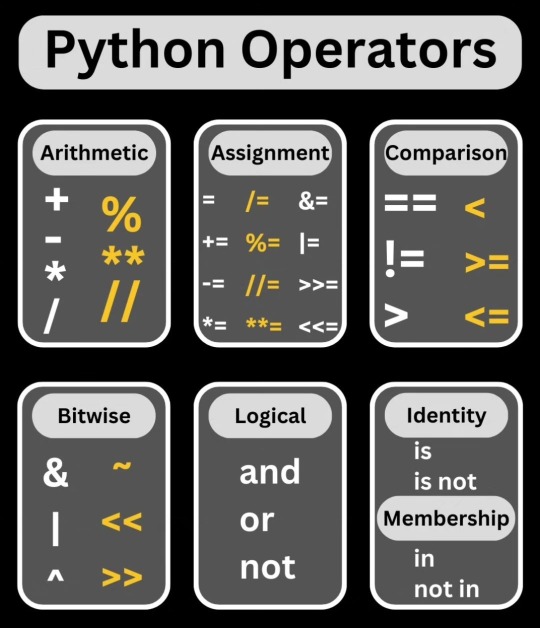
Post #106: Python.Hub on Instagram, The different operators in Python, 2023.
#i love coding#programming#coding#learning#education#i love programming#coding is fun#programming language#i love python#coding for kids#python hub#python coding#learn python#zen of python#python tutorial#python
19 notes
·
View notes
Text
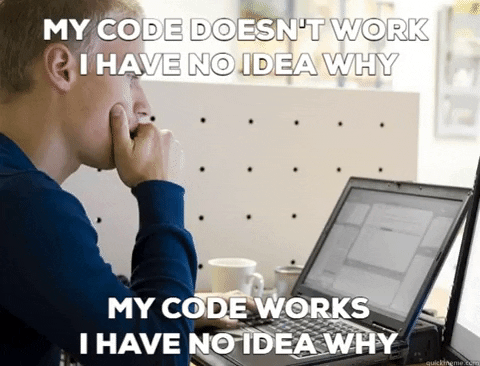
#programmerlife#programmingmemes#developerlife#developermemes#codinglife#codingmeme#python programmer#programming#data science#machine learning#learn python#meme humor#memedaddy#funny#lol#programminglife#webdev#programmer
6 notes
·
View notes
Text
How to Find Element in XML Python?

Read more at: https://elvanco.com/blog/how-to-find-element-in-xml-python
17 notes
·
View notes
Text
Python Day 5
Today we warm up by completing Exercise 25. This is even more practice with functions and variables!

To run the program we call python in the terminal and import ex25 from there.
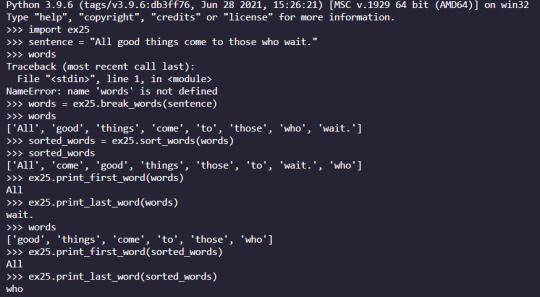
As I was working through calling the different functions in the terminal I realized that I missed a function - specifically the one that sorted a sentence. I called it and ended up getting a mess of individual letters. After bug hunting I found the issue to be that I called sort_words(sentence) instead of sort_words(words)

After fixing those issues I finished running through the function calls in the terminal and it went great!

Up next is Exercise 26! We are halfway through the book and it is time for a test. We are given broken code that we copy paste into a file. Our job is to fix it and get the program running! As I went through the program I left comments wherever I was fixing code. Below is my finished and fixed program.
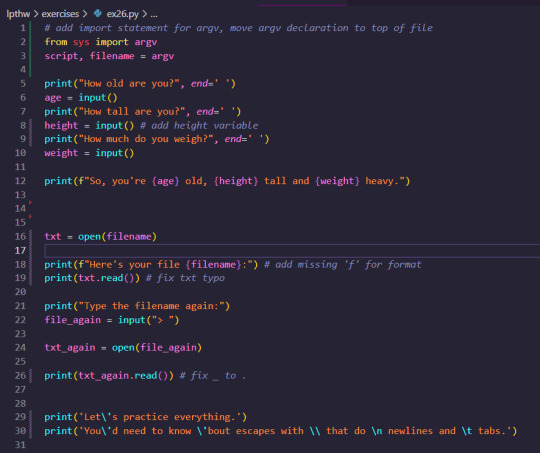

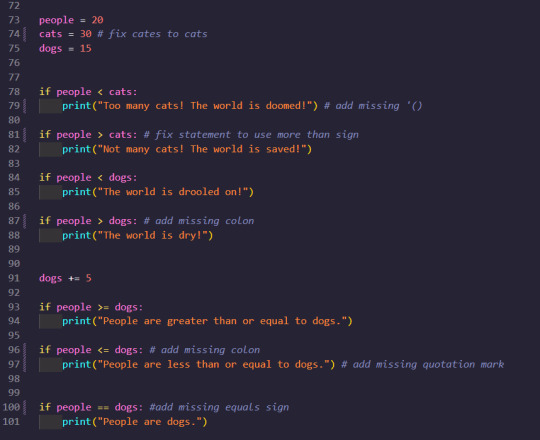
And here is the output in the terminal:

Exercise 27 went over different booleans as well as a chart to memorize. The next practical was exercise 28 where you type in different statements then guess if they will be true or false. With my previous experience in programming I already knew a lot - the only thing that tripped me up was NOT OR booleans. Here's the output of the terminal!

Chugging right along to Exercise 29! ex29 introduced if statements. I already know lots about if statements from Javascript so this is more of a refresher than anything.

And then the output:

Exercise 30 introduces Else If statements.

And the output:

Exercise 31 combines everything that we've learned about If/Elif statements with the new concept of Nested statements. Using nested statements we are able to write a very simple Choose Your Own Adventure text game.
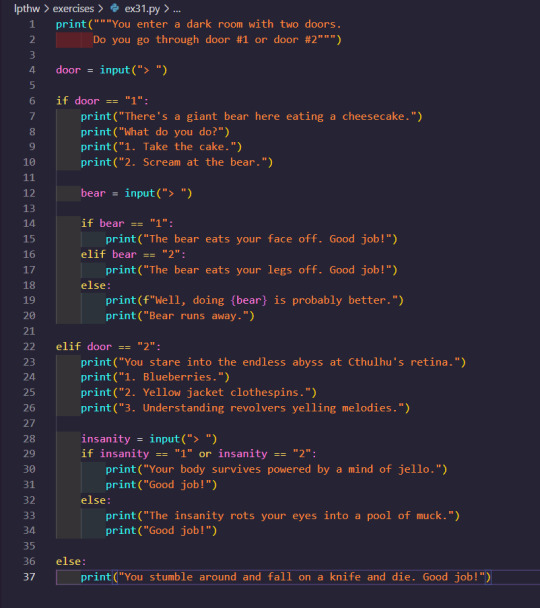
Here are a couple different runs I did with this program. My first try was not the best - I ended up having my mind turned into Jello!

My second run went better! I ran into a bear but I survived.

For the study drill it challenged me to write my own text game. I made a very simple one and got about halfway through where I want it to be.

That's it for today folks!
#learn python with f.m.#learn to code#lpthw#python#learn python#codeblr#coding#code#programming#transgender programmer#image undescribed
6 notes
·
View notes